![]()
![]()
![]()
Use LEFT and RIGHT arrow keys to navigate between flashcards;
Use UP and DOWN arrow keys to flip the card;
H to show hint;
A reads text to speech;
60 Cards in this Set
- Front
- Back
|
What is the term for voluntarily slowing your heart rate?
|
Vagal Toning
|
|
|
What kind on synapses do you have in smooth and skeletal muscle?
|
Chemical synapses
|
|
|
What kind of synapse do you have in cardiac muscle?
|
Electrical
|
|
|
What kind of receptor does ACh bind to on muscle motor endplates?
|
Nicotinic receptors
|
|
|
What creates the end-plate potential (EPP)?
|
Net influx of Na+ through ligand gated channels depolarizes the muscle membrane (step 4)
|
|
|
What is the 1st step in converting an electrical signal to a mechanical response?
|
Action potential of somatic motoneuron reaches nerve terminus
|
|

What is the 2nd step in converting an electrical signal to a mechanical response?
|
Voltage gated Ca++ channels on the nerve open. Ca++ entry into the nerve endings triggers exocytosis of ACh containing vesicles
|
|
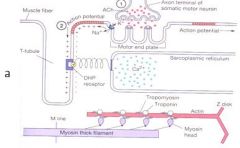
What is the 3rd step in converting an electrical signal to a mechanical response?
|
Acetylcholine diffuses into synaptic cleft and binds to nicotinic channel receptors on muscle motor endplate.
|
|
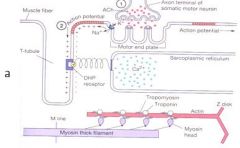
What is the 4th step in converting an electrical signal to a mechanical response?
|
Net influx of Na+ through the acetylcholine (ligand) gated channels depolarizes the muscle membrane, creating an end-plate potential (EPP). In normal situations, the EPP always creates a muscle action potential.
|
|
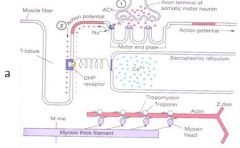
What is the 5th step in converting an electrical signal to a mechanical response?
|
The action potential spreads from the neuromuscular junction along the fiber membrane and through the t-tubules.
|
|
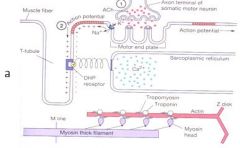
Where is the terminal cistern located?
|
On either side of a T-tubule. Between a T-tubule and the sarcoplasmic reticulum.
|
|
|
What does the sarcoplasmic reticulum contain?
|
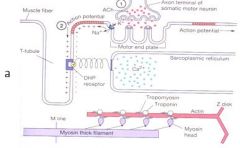
Things like Ca++
|
|
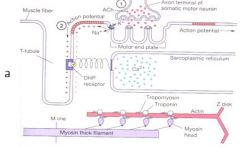
What is the 6th step in converting an electrical signal to a mechanical response?
|
Voltage sensitive DHP receptors in the T-tubule allow Ca++ to enter the cell into the terminal cistern area.
|
|
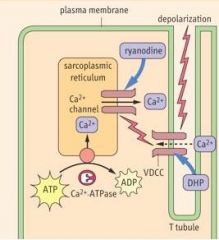
What type of calcium channel are DHP receptors?
|
DHP receptors are a type of L-type calcium channel
|
|
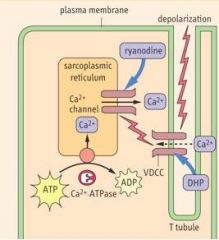
What causes ryanodine channels on the sarcoplasmic reticulum to open?
|
The increase in intracellular calcium causes ryanodine channels to open
|
|
|
What is one T-tubule and two cisterns?
|
A Triad
|
|
|
What is the purpose of T-tubules?
|
To disseminate the energy down into a muscle cell
|
|
|
In skeletal muscle, what directly activates the release of Ca++ from the Sarcoplasmic reticulum?
|
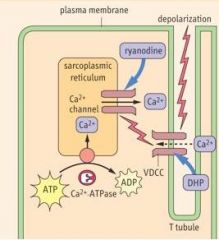
VDCCs (voltage-dependent calcium channels)
|
|
|
What signaling molecule triggers muscle contraction?
|
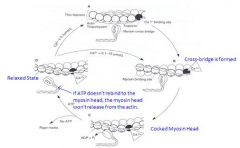
Ca++
|
|
|
What is in the sarcoplasmic reticulum that transports Ca++ back into the lumen, decreasing the cytoplasmic Ca++ concentration, and the muscle relaxes?
|

Ca++-ATPase in the sarcoplasmic reticulum
|
|
|
What types of muscle use VDCCs to allow entry of Ca++?
|
Skeletal and Cardiac Muscle
|
|
|
What is a calcium channel blocker used for treatment of hypertension?
|
DHP = dihydropyridine, nifedipine
|
|
|
What allows myosin to release inorganic phosphate from ATP hydrolysis and complete the power stroke?
|
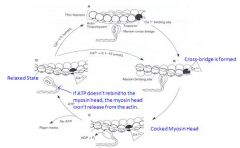
Ca++ binding to troponin, pulling tropomyosin off the myosin binding site of actin
|
|
|
What happens at the end of a power stroke under normal circumstances?
|
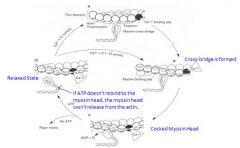
The myosin cross bridges release ADP and remain tightly bound to actin until ATP binds the myosin head and releases it from the binding site.
|
|
|
What makes myosin heads lock in a state of rigor?
|
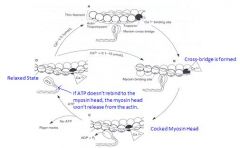
No ATP to release the head
|
|
|
When does the muscle fiber relax? (chemically)
|
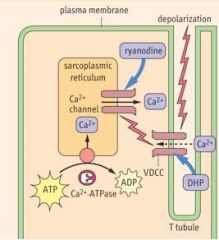
When Ca++ is transported back into the sarcoplasmic reticulum
|
|
|
What causes hydrolysis of ATP in the cross-bridge cycle?
|

The myosin head acts as an ATPase
|
|
|
What is a ball at the end of the nerve ending. Inside of which are synaptic vesicles created within the neuron?
|
Presynaptic Bouton (nerve terminus)
|
|
|
What contains the neurotransmitters and can have 100s or 1000s in a bouton?
|
Synaptic Vesicles
|
|
|
What determines how much time it will take from the release of a neurotransmitter to stimulate the contraction of the muscle?
|
The distance of the Synaptic Cleft
|
|
|
What is a type of SNARE protein, involved in the fusion of membranes in the exocytosis of vesicles?
|
Synaptobrevin
|
|
|
What protein regulates the number of synaptic vesicles available for exocytosis?
|
Synapsin
|
|
|
What is the amount of neurotransmitter contained in one synaptic vesicle?
|
Quantum
|
|
|
What does the amount of neurotransmitter released depend upon?
|
The number of vesicles that fuse with the presynaptic membrane in response to Ca++ influx
|
|
|
T/F The motor end plate is a receptor region -- it contains lots of receptors specific for a particular neurotransmitter.
|
True
|
|
|
what does a Ligand Gated Sodium Channel activate?
|
ACh binds and Na+ enters the cell
|
|
|
T/F
Ligand gated sodium channel receptors has 2 binding sites for ACh but only one need to be bound to ACh for the response to occur. |
False
Both need to be bound to occur |
|
|
What happens as more and more ligand gated sodium channel receptors bind to ACh?
|
The muscle stimulation gets bigger and bigger
|
|
|
What is the change in membrane potential induced by the action of multiple mini end plate potentials called?
|
The End Plate Potential
|
|
|
What molecule is primarily involved in the depolarization of the myocyte?
|
Na+
|
|
|
What molecule is more significant than Na+ at the synaptic cleft?
|
Ca++
|
|
|
What molecule sets off a cascade which causes the NT vesicles inside the motor neuron to migrate to the synaptic cleft and release ACh?
|
Ca++
|
|
|
What molecule is released based upon the quantum of energy that comes from the bouton?
|
Ca++
|
|
|
What is the primary NT substance released by motor neurons to stimulate a skeletal muscle contraction?
|
ACh
|
|
|
What is bound to the motor end plate region and helps to degrade ACh and allows for its resorption back into the bouton?
|
Acetylcholineesterase
(ACh-Esterase) |
|
|
What toxin is found in blow fish and blocks Na+ channels on BOTH the nerve process and the muscle cell?
|
Tetrodotoxin
|
|
|
What blocks ACh release into the synaptic cleft by dissolving SNARE proteins in the motor neuron?
|
Tetanus and Botulinus Toxin
|
|
|
What are Reversible cholinesterase inhibitors?
|
Physostigmine & Neostigmine
|
|
|
What are Irreversible cholinesterase inhibitors found in fertilizers?
|
Organophosphate
|
|
|
What facillitates binding of ACh at the motor end plate?
|
Nicotine and ACh
|
|
|
What are Fast Acting competative inhibitors competing for ACh receptors?
|
Alpha-bungarotoxin (Cobra Venom)
|
|
|
What are Slow Acting competative inhibitors competing for ACh receptors, used in surgery for temporary relaxation of muscles?
|
Turbocurrarine (curare)
|
|
|
What blocks potassium channels, preventing repolarization? (has the same effect as a cholinesterase inhibitor)
|
Dendrotoxin (mamba venom)
|
|
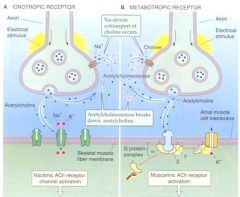
What type of receptor has:
Ligand gated ion channel Open or close in response to a chemical stimulus Nicotinic Receptor |
Ionotropic Receptor
|
|
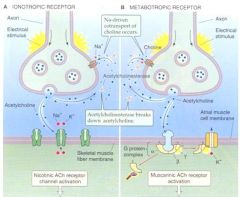
What type of receptor:
Do not form an ion channel pore Instead, are indirectly linked with ion-channels on the plasma membrane of the cell through signal transduction mechanisms When the NT is released and attaches to the metabotropic receptor, it initiates a G-protein cascade Muscarinic Receptor |
Metabotropic Receptor
|
|
|
Where is Troponin T?
|

Attached to tropomyosin
|
|
|
Where is Troponin I?
|
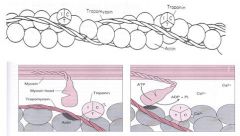
Attached to actin
|
|
|
Where is Troponin C?
|
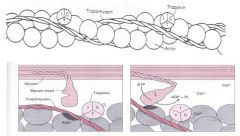
Troponin C is the Ca++ binding site
|
|
|
When Troponin I is attached to actin what happens?
|
It is Inactive (get it...I, oh the irony of nomenclature)
|
|
|
T/F
The myosin has a tail and a hinge as well as multiple heads. On the head, there is an alkali component that helps stabilize it. There is also a regulatory component that regulates ATPase. |
True
|

